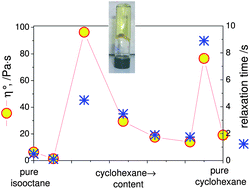Impact of branching on the viscoelasticity of wormlike reverse micelles†
Abstract
We present an investigation on the effect of inter-micellar connections (branches) on the rheology of wormlike micelles. The system chosen is made of

* Corresponding authors
a Consorzio per lo sviluppo dei Sistemi a Grande Interfase (CSGI), Firenze (FI), Italy
b
Università del Molise (DIAAA), v. De Sanctis, I-86100 Campobasso (CB), Italy
E-mail:
angelico@unimol.it
c Malvern Instruments Limited, Malvern, Worcestershire, UK
d Dipartimento di Scienze Chimiche e Geologiche, Università di Cagliari, I-09042 Monserrato, CA, Italy
e Physical Chemistry, Lund University, SE-221 00 Lund, Sweden
f
Dipartimento di Chimica, Università di Bari, v. Orabona 4, I-70126 Bari (BA), Italy
E-mail:
gerardo.palazzo@uniba.it
We present an investigation on the effect of inter-micellar connections (branches) on the rheology of wormlike micelles. The system chosen is made of

 Please wait while we load your content...
Something went wrong. Try again?
Please wait while we load your content...
Something went wrong. Try again?
R. Angelico, S. Amin, M. Monduzzi, S. Murgia, U. Olsson and G. Palazzo, Soft Matter, 2012, 8, 10941 DOI: 10.1039/C2SM26528A
To request permission to reproduce material from this article, please go to the Copyright Clearance Center request page.
If you are an author contributing to an RSC publication, you do not need to request permission provided correct acknowledgement is given.
If you are the author of this article, you do not need to request permission to reproduce figures and diagrams provided correct acknowledgement is given. If you want to reproduce the whole article in a third-party publication (excluding your thesis/dissertation for which permission is not required) please go to the Copyright Clearance Center request page.
Read more about how to correctly acknowledge RSC content.
 Fetching data from CrossRef.
Fetching data from CrossRef.
This may take some time to load.
Loading related content
